As the vibrant hues of summer fade, you might find yourself reflecting on your balcony garden. Did your tomatoes thrive, or did they barely produce? Did your herbs flourish, or did they bolt too quickly? Many gardeners experience moments of “what went wrong?” when reviewing their growing season. This feeling is completely normal, especially for those navigating the unique challenges of small-space container gardening. Rather than dwelling on disappointment, use this fall as a powerful opportunity for growth. You gain valuable insights by examining last summer’s challenges. You transform past missteps into a clear action plan for a more successful and abundant garden next year.
This “Fall Regret Audit” helps you identify common balcony garden mistakes. We convert these learning opportunities into practical, actionable steps for your future garden planning. You will learn from previous experiences. You will understand how to plan a better container garden. Let’s dig in and ensure your next growing season is your best one yet, turning those summer regrets into future triumphs.
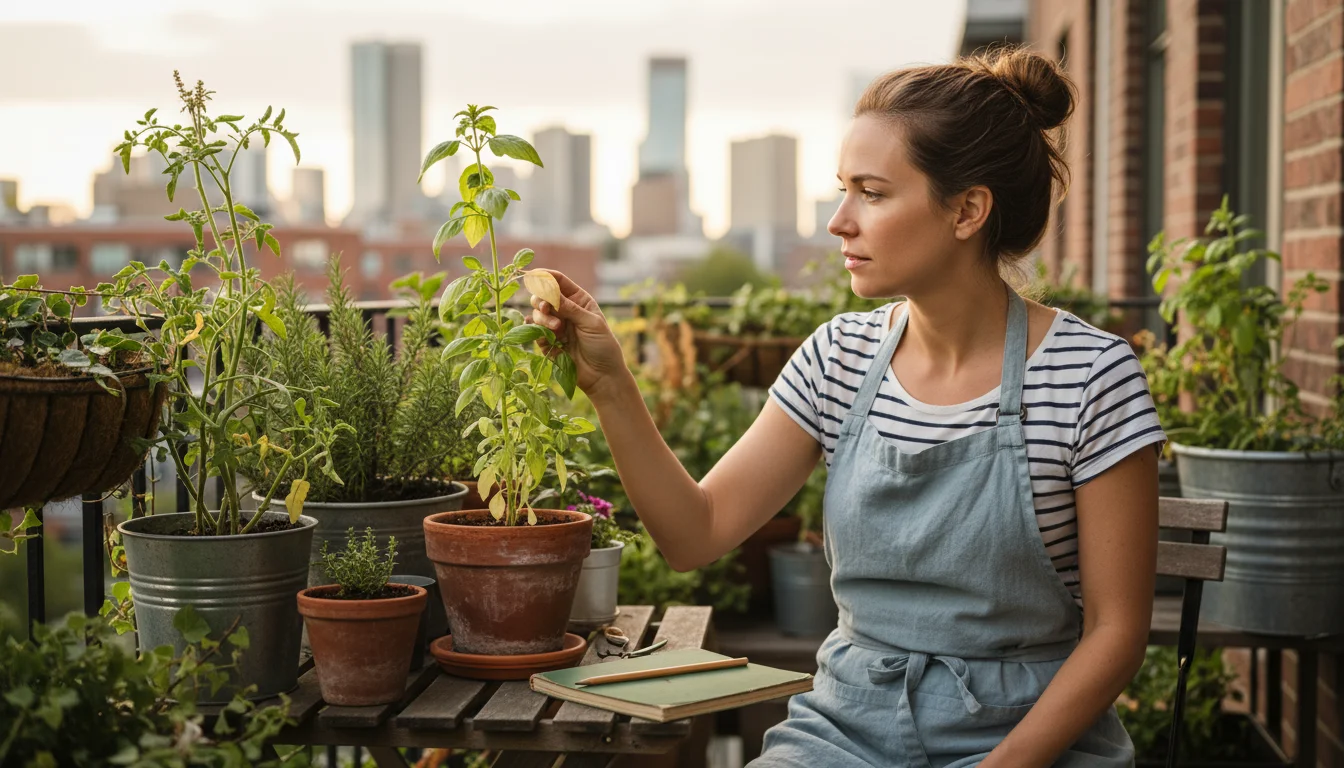
Setting the Stage for Success: Why a Fall Audit Matters
Many gardeners view fall as a time for winding down, but for container gardeners, it is prime time for garden planning. A fall audit gives you the necessary perspective to identify balcony garden mistakes and prevent them from recurring. Think of it as a detailed debrief. You review what performed well, what struggled, and why. This process helps you develop a more informed and effective strategy for next year’s planting. You transform vague hopes into concrete strategies for success. Learning from gardening mistakes becomes a powerful tool for your growth as a gardener.
You gain several key benefits from this strategic review. First, you leverage fresh memories of the growing season. The struggles with pests, the joy of a perfect harvest, the plant that inexplicably withered, these memories are still vivid. Documenting them now provides accurate data. Second, you have ample time for research and sourcing. You can investigate new plant varieties, research better container options, or learn about soil amendments without the rush of spring planting. Third, you prepare for the future. You identify what to do differently in the garden next year. This proactive approach ensures you avoid last-minute decisions and instead embark on your next season with confidence and a clear vision. This detailed reflection forms the bedrock of how to plan a better container garden.
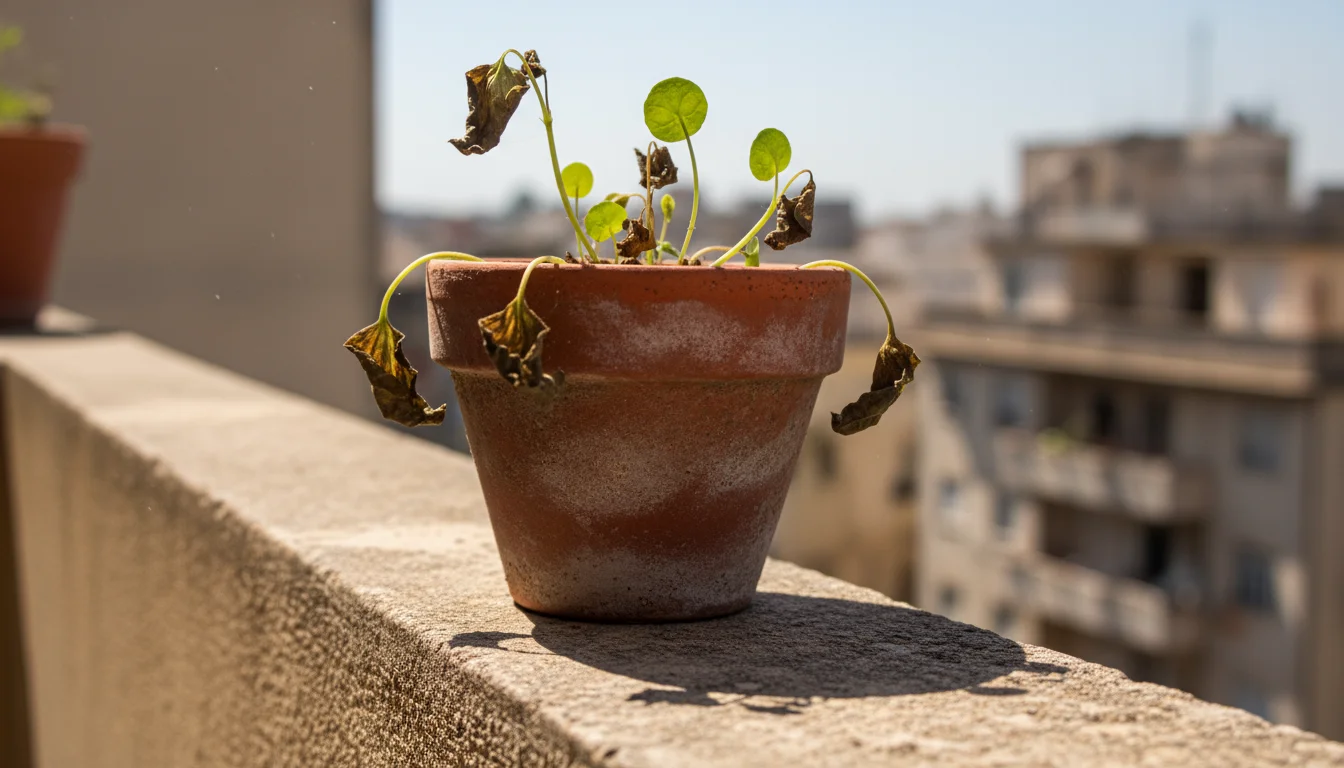
Mistake 1: Underestimating Your Balcony Microclimate
One of the most frequent balcony garden mistakes involves misjudging your specific growing environment. A balcony or patio, despite its small size, possesses a unique microclimate. This includes variations in sunlight exposure, wind patterns, and even reflected heat from nearby buildings or surfaces. Many gardeners simply assume their balcony gets “full sun” or “part shade” based on general orientation. This broad assumption often leads to plants failing to thrive. For example, a south-facing balcony might get intense, unfiltered sun all day, leading to scorched leaves on delicate plants. Conversely, a west-facing balcony might receive harsh afternoon sun, heating containers excessively and stressing plants.
Underestimating wind is another common oversight. Balconies, especially on higher floors, often experience significant wind tunnel effects. Consistent strong winds physically damage plants, dehydrate foliage rapidly, and even dislodge containers. This constant stress stunts growth and reduces yields. Similarly, radiated heat from concrete, brick, or glass surfaces elevates temperatures within your containers. This requires more frequent watering and affects plant selection.

How to Audit and Plan for Your Microclimate:
- Document Sunlight Hours: Spend a typical sunny day observing your balcony. Every hour, note which areas receive direct sunlight and which are in shade. Record the duration and intensity. For example, “East corner: direct sun 7 AM – 11 AM, then shade. West side: shade until 2 PM, then intense sun until sunset.” Do this for at least three different days across a week to capture variations.
- Assess Wind Exposure: Observe prevailing wind directions and their intensity. Does wind consistently buffet a certain corner? Do your containers get knocked over? Are leaves frequently torn? Note down these observations. Consider using a small anemometer if you want precise data, but visual observation provides ample information for garden planning.
- Check for Reflected Heat: Feel surrounding surfaces like walls, railings, and flooring during peak sun hours. Notice if they feel excessively hot. This indicates radiated heat that will impact your plants and soil temperatures.
- Map Your Balcony: Create a simple sketch of your balcony. Divide it into zones based on your observations. Label areas as “Full Sun – Intense Afternoon,” “Morning Sun Only,” “Part Shade – Wind-Exposed,” etc.
- Plan Zoning and Plant Placement: Use your map for next year’s garden planning. Place sun-loving, heat-tolerant plants in the intense sun zones. Reserve shadier spots for leafy greens or herbs that prefer less direct light. Implement windbreaks using taller, sturdier plants or strategic placement of furniture for vulnerable areas.
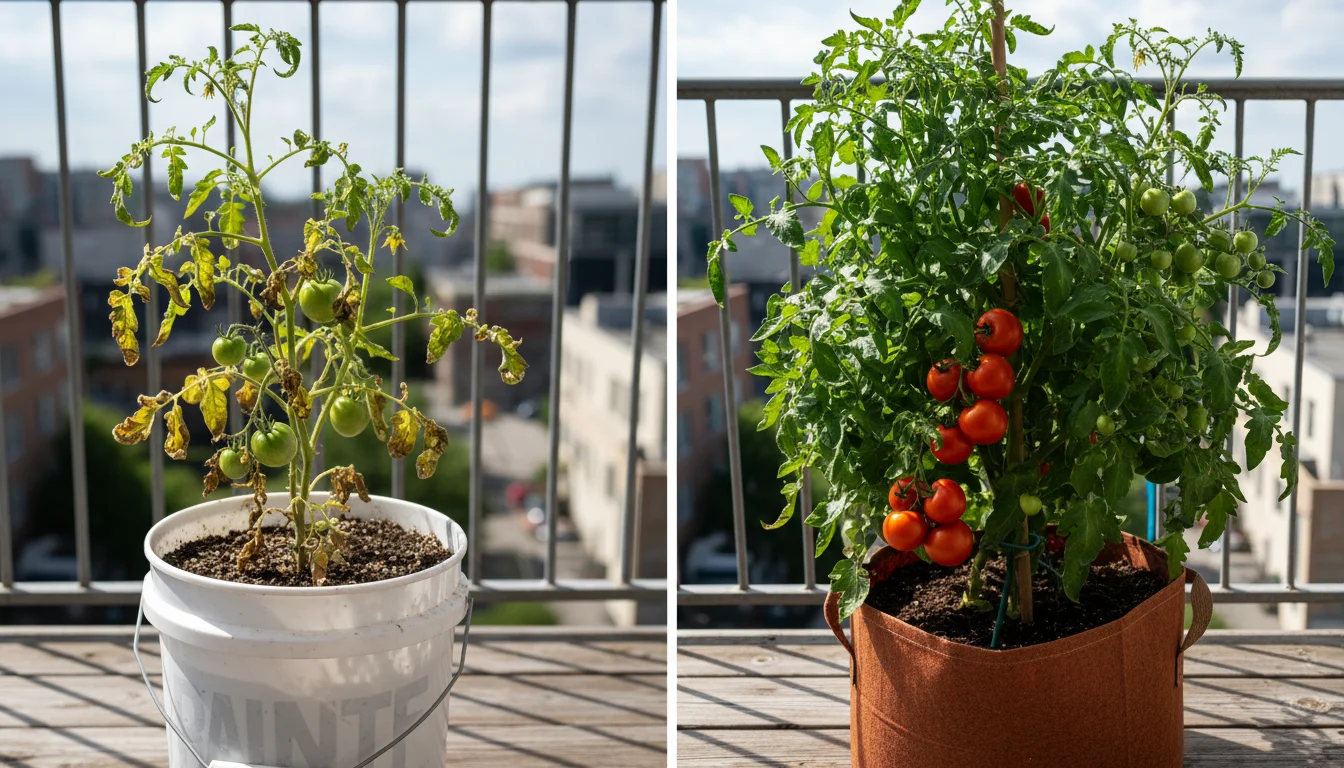
Mistake 2: Neglecting Container Size and Drainage
Another prevalent issue in balcony gardening stems from improper container selection. Choosing containers that are too small or lack adequate drainage is a common balcony garden mistake. Small containers restrict root growth, leading to stunted plants and reduced yields. They also dry out much faster, forcing you into a constant battle against dehydration. This stress on the plants diminishes their vigor and makes them more susceptible to pests and diseases. For instance, a tomato plant in a 5-gallon pot will typically produce far less than one in a 15-gallon container due to limited root space and nutrient availability.
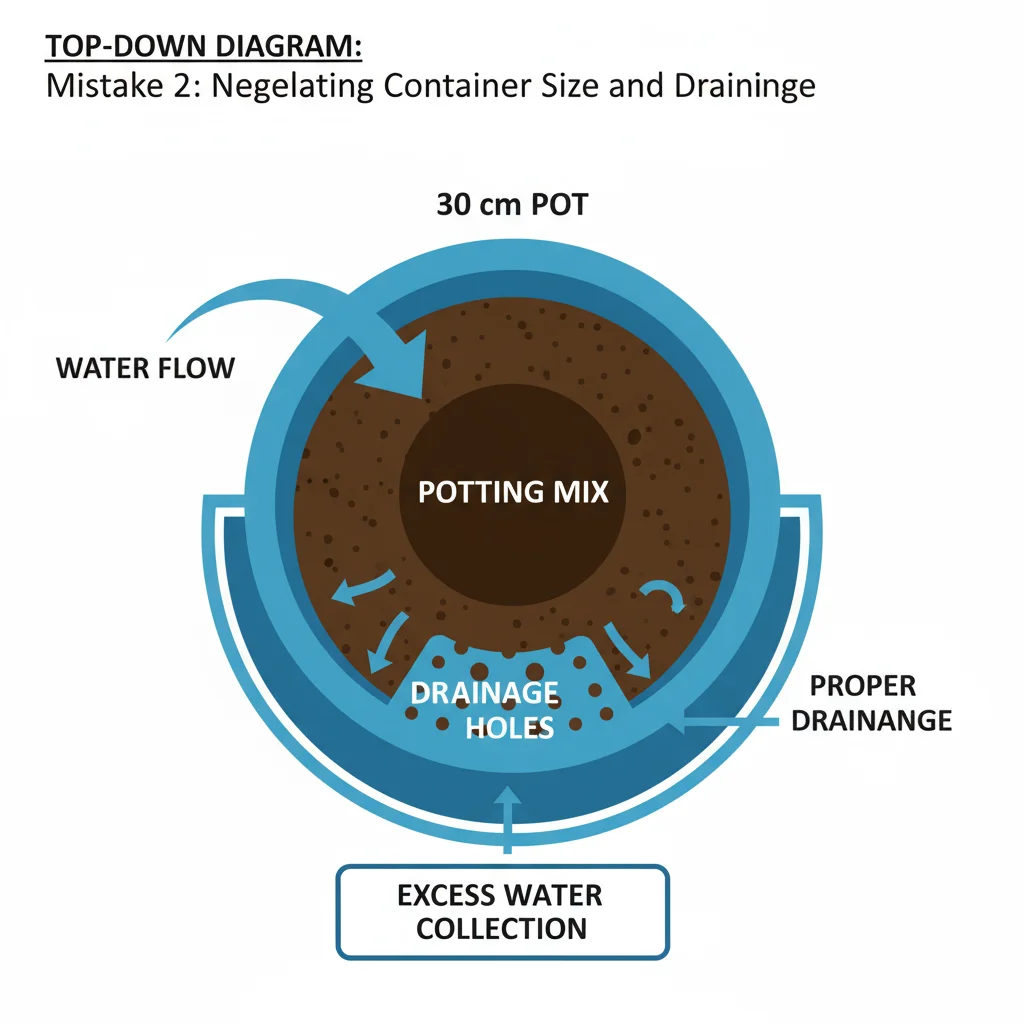
Drainage, or how water moves through soil, is equally critical. Without sufficient drainage holes, water accumulates at the bottom of the pot. This creates anaerobic conditions where roots essentially drown. Root rot, a common and often fatal issue, develops rapidly in waterlogged soil. Even containers with drainage holes can fail if the holes are too small, few, or become blocked by soil particles. You ensure healthy root systems and prevent water-related problems by focusing on proper container size and superior drainage. This significantly improves how to plan a better container garden.

How to Choose and Prepare Containers for Optimal Growth:
- Match Container Size to Plant Needs:
- Herbs (basil, cilantro): 6-8 inch diameter.
- Bushy greens (lettuce, spinach): 8-10 inch diameter.
- Root vegetables (carrots, radishes): At least 12 inches deep for longer varieties.
- Peppers, Eggplant, Bush Beans: 5-gallon equivalent (10-12 inch diameter, 10-12 inches deep).
- Tomatoes (determinate), Cucumbers, Zucchini: 15-20 gallon equivalent (18-24 inch diameter, 18-24 inches deep).
- Small fruit trees (dwarf citrus), large shrubs: 25+ gallon equivalent.
Always opt for a larger container if uncertain. A plant will rarely suffer from too much space, but it will certainly struggle with too little.
- Ensure Ample Drainage Holes: Every container must have drainage holes. Ideally, aim for multiple holes at the base, each at least 0.5 inches in diameter. If your decorative pots lack holes, place your growing container (with holes) inside the decorative one. This creates a “cachepot” system.
- Prevent Blocked Drainage: Avoid putting gravel, broken pottery, or packing peanuts at the bottom of pots. This practice actually hinders drainage by creating a perched water table. Instead, a simple coffee filter or a piece of landscaping fabric over the drainage holes prevents soil from washing out while allowing water to pass freely.
- Consider Material: Terracotta pots are porous and allow soil to breathe, but they dry out quickly. Plastic and glazed ceramic retain moisture longer but can overheat in intense sun. Fabric grow bags offer excellent aeration and drainage. They also help prevent root circling.
- Elevate Containers: Use pot feet or small blocks to slightly elevate your containers off the ground. This improves airflow around the drainage holes. It also prevents water from pooling underneath, especially on surfaces that do not easily drain.
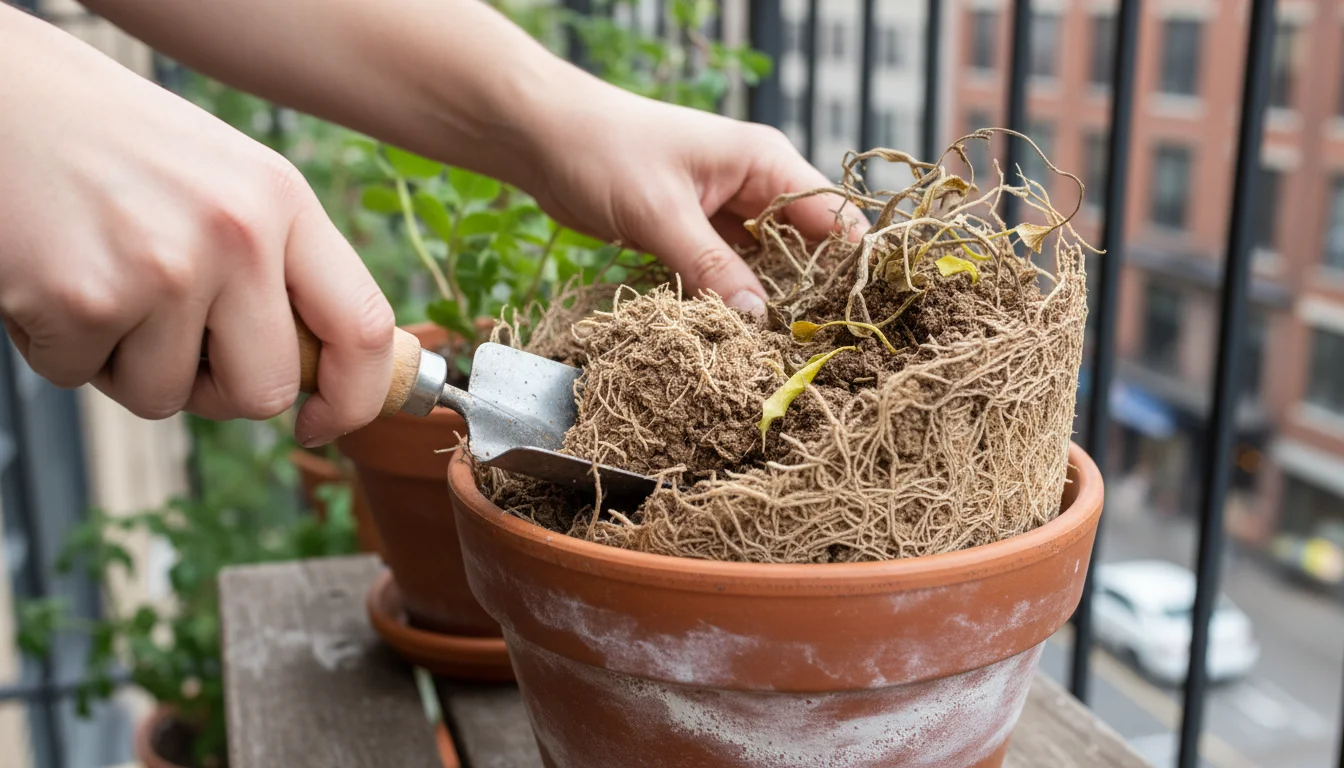
Mistake 3: Overlooking Soil Quality and Nutrition
The foundation of any thriving garden is healthy soil. In container gardening, this translates to using high-quality potting mix and understanding its nutritional needs. A common balcony garden mistake is reusing old, depleted potting mix or using garden soil directly in containers. Garden soil compacts easily in pots, becomes waterlogged, and often introduces pests and diseases. Old potting mix lacks structure and nutrients, offering little support for new plants. This results in weak growth, pale leaves, and poor harvests, even if other conditions are ideal.
Beyond the initial mix, gardeners often neglect ongoing plant nutrition. Container plants deplete nutrients from their limited soil volume much faster than in-ground gardens. Many assume a single application of fertilizer suffices or that store-bought potting mix contains enough nutrients for an entire season. This oversight leads to nutrient deficiencies. You notice yellowing leaves, stunted growth, or a lack of flowering and fruiting. Understanding and actively managing soil quality and plant nutrition prevents these issues. This ensures robust growth throughout the season. These considerations are vital when learning from gardening mistakes and developing your garden planning strategy.
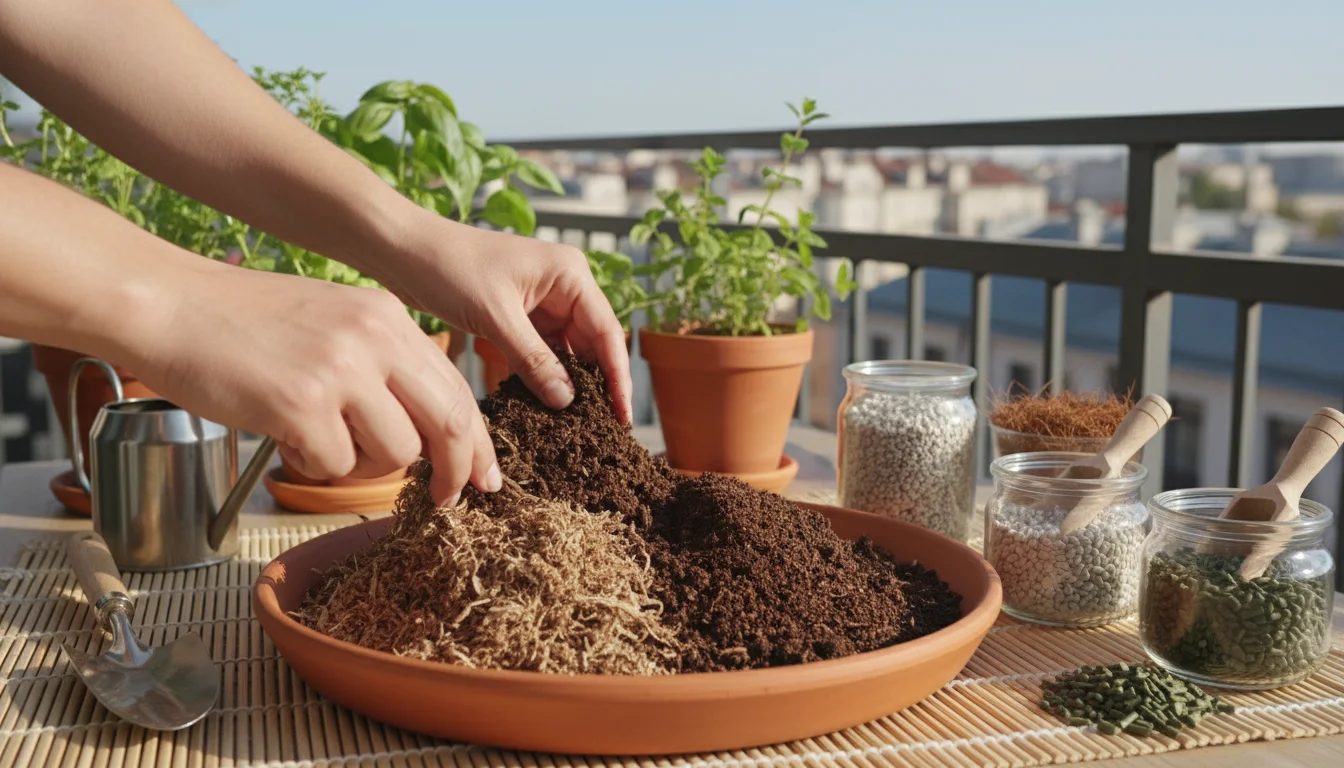
Creating and Maintaining Nutrient-Rich Potting Mix:
- Start with a Quality Potting Mix: Never use garden soil in containers. Invest in a high-quality, sterile potting mix specifically formulated for containers. These mixes typically contain peat moss, coco coir, perlite, or vermiculite. These ingredients provide excellent drainage, aeration, and moisture retention.
- Enhance Your Mix:
- Compost: Mix 10-20% high-quality compost into your potting mix. Compost adds essential slow-release nutrients, improves soil structure, and introduces beneficial microbes. This boost is incredibly valuable.
- Worm Castings: A small amount of worm castings (5-10%) provides a gentle, nutrient-rich amendment that promotes vigorous growth.
- Slow-Release Fertilizer: Incorporate an organic slow-release granular fertilizer according to package directions. This provides a baseline of nutrients for the first few weeks.
- Understand Ongoing Fertilization: Your plants will deplete nutrients over time. Plan for regular feeding.
- Liquid Fertilizers: Use a balanced liquid fertilizer every 2-4 weeks, especially for heavy feeders like tomatoes, peppers, and fruiting plants. Dilute to half strength to avoid over-fertilizing.
- Compost Tea: Brew your own compost tea for an organic, nutrient-rich liquid feed that also enhances microbial life.
- Signs of Deficiency: Learn to recognize common nutrient deficiencies. Yellowing lower leaves might indicate nitrogen deficiency. Purple undersides suggest phosphorus issues. Pale growth between green veins points to iron deficiency. Adjust your feeding regimen accordingly.
- Avoid Reusing Depleted Soil: While you can sometimes amend and reuse potting mix for certain plants, it is generally best practice to refresh your containers with new mix each season for annuals. If you must reuse, remove as many old roots as possible, and amend heavily with fresh compost, worm castings, and a balanced fertilizer. However, for best results, especially with heavy feeders, new potting mix is ideal.
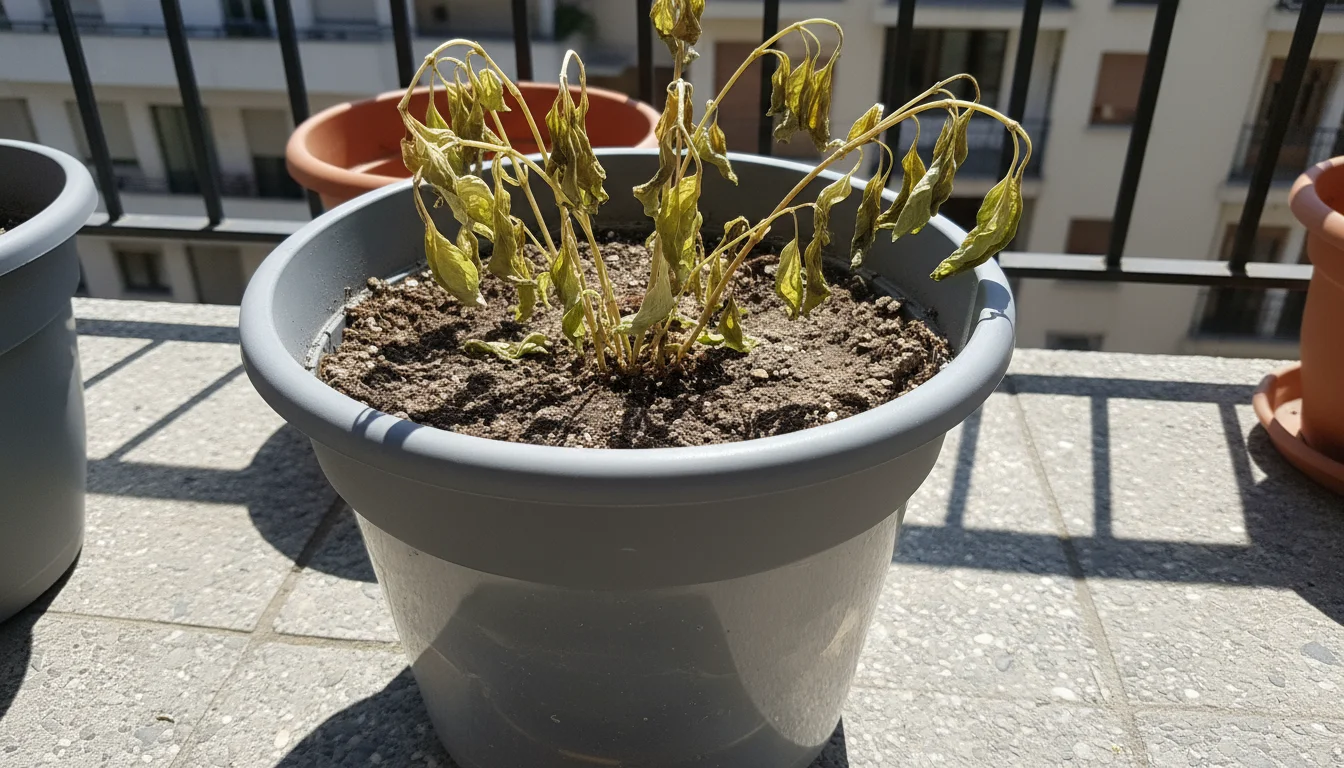
Mistake 4: Poor Watering Habits and Scheduling
Watering seems simple, yet it is a frequent source of balcony garden mistakes. Overwatering, underwatering, and inconsistent watering all severely impact plant health. Overwatering suffocates roots, leading to root rot and fungal diseases. The soil remains constantly soggy, preventing oxygen from reaching the roots. Underwatering, especially in hot, windy balcony environments, causes plants to wilt, stress, and eventually die. Inconsistent watering, where plants experience extreme dry spells followed by drenching, can lead to blossom end rot in tomatoes and peppers, or split fruit. Container plants dry out much faster than in-ground plants due to smaller soil volume and increased exposure to air movement and sun. You must develop precise, attentive watering habits for successful container gardening.
The key to effective watering lies in understanding your plants’ needs and observing your soil. Many new gardeners water on a fixed schedule. This schedule often does not account for variations in weather, plant size, or container material. A hot, sunny, windy day demands more water than a cool, cloudy one. A small seedling needs less water than a mature fruiting plant. Understanding these dynamics and responding to them prevents many common issues. This careful approach to hydration directly influences how to plan a better container garden and avoid previous learning from gardening mistakes.

Mastering Watering for Container Gardens:
- Check Soil Moisture, Do Not Guess: Do not water based on a calendar or how the surface looks. Stick your finger 2-3 inches deep into the soil. If it feels dry, it is time to water. If it feels moist, wait. Alternatively, lift the container. A dry pot feels significantly lighter than a moist one.
- Water Deeply and Thoroughly: When you water, do so until water drains freely from the bottom of the pot. This ensures the entire root ball receives moisture. Shallow watering encourages shallow roots, making plants more susceptible to drought stress.
- Water at the Base: Direct water to the soil level, not onto the leaves. Wet foliage, especially in the evening, creates an ideal environment for fungal diseases.
- Consider Time of Day: The best time to water is usually in the early morning. This allows plants to absorb water before the heat of the day. It also gives any wet foliage time to dry, reducing disease risk. Watering in the evening is a second-best option if early morning is not feasible, but try to avoid getting leaves wet.
- Adapt to Weather and Plant Size:
- Hot, Sunny, Windy Days: Check your plants daily, and sometimes twice daily.
- Cool, Cloudy Days: Check every 2-3 days.
- Small Seedlings: Require less frequent but consistent moisture.
- Mature, Fruiting Plants: Heavy water users. They often need daily watering during peak season.
- Mulch Your Containers: Apply a 1-2 inch layer of mulch (e.g., shredded leaves, straw, coco coir) on top of your potting mix. Mulch reduces evaporation, keeps soil temperatures more consistent, and suppresses weeds.
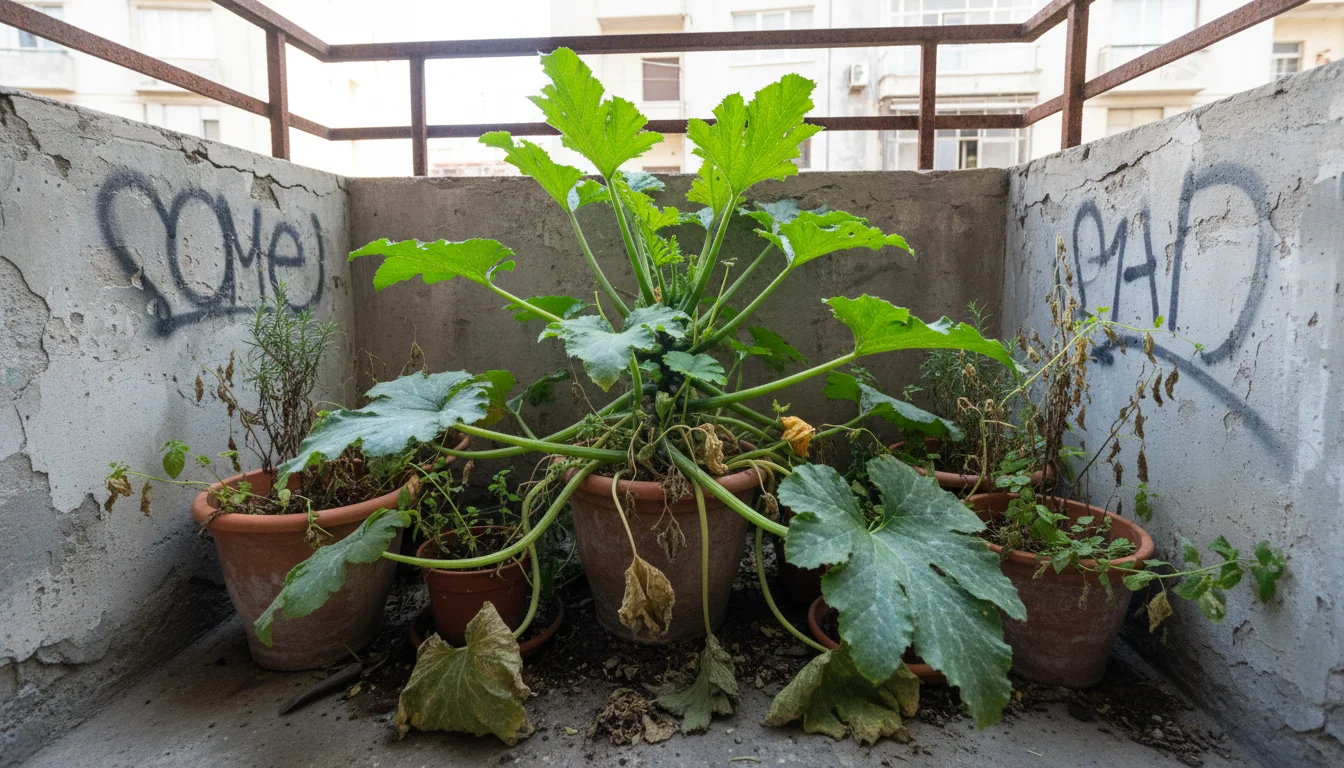
Mistake 5: Choosing the Wrong Plants for Your Space
Enthusiasm often leads new gardeners to select plants based on their desires rather than the realities of their balcony. This is a significant balcony garden mistake. You might envision sprawling zucchini vines or a towering corn patch. These plants often outgrow their containers, choke out neighboring plants, or simply do not yield well in confined spaces. Similarly, choosing sun-loving plants for a shady balcony, or delicate varieties for a windy, exposed spot, guarantees disappointment. You set yourself up for struggle when plant needs conflict with your environmental conditions.
Successful balcony gardening requires thoughtful plant selection. This means matching plant requirements to your specific microclimate, available container sizes, and personal commitment level. You thrive by understanding which plants genuinely perform well in containers and compact spaces. You select varieties known for their dwarf size, bush habit, or suitability for vertical growth. This careful selection prevents overcrowding, minimizes stress, and maximizes your harvest potential. This is a critical step in how to plan a better container garden and prevents you from learning from gardening mistakes repeatedly.
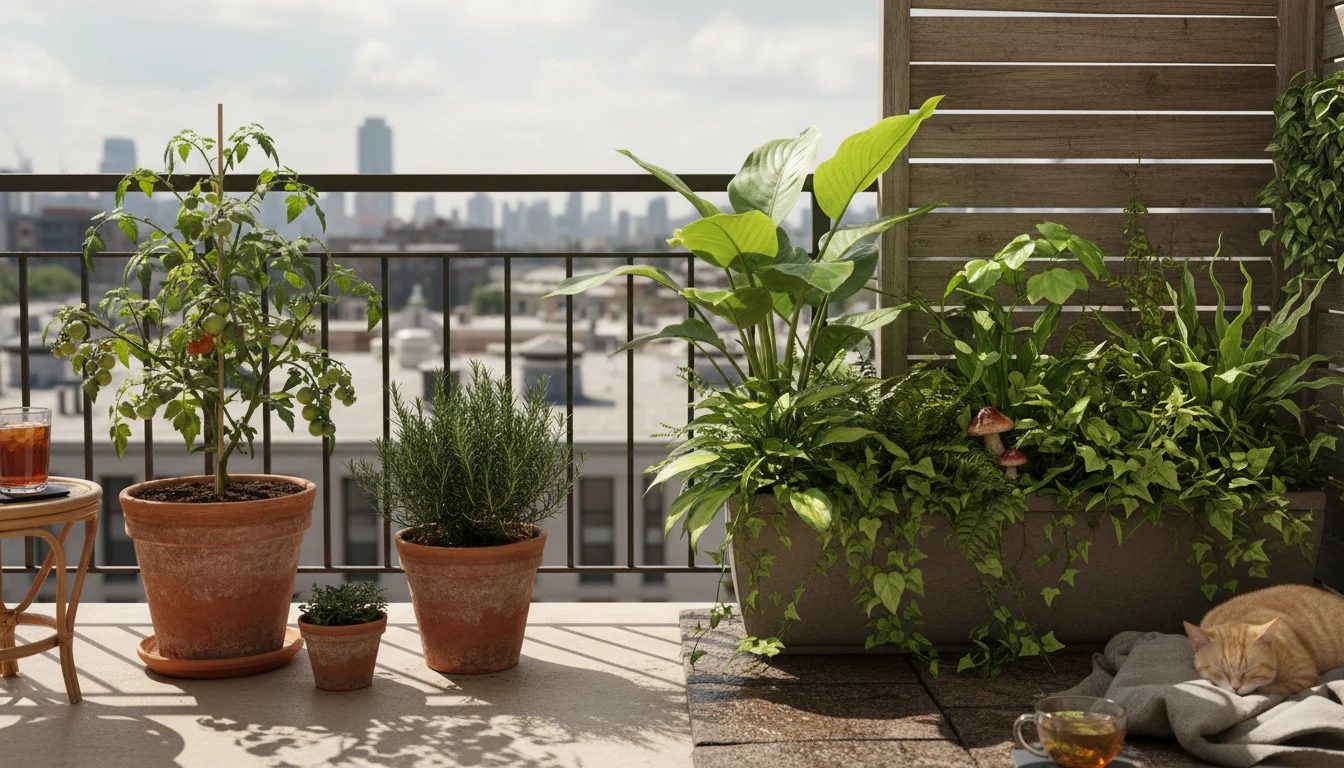
Smart Plant Selection for Small Spaces:
- Assess Your Microclimate (Revisited): Refer back to your balcony map from Mistake 1. Be brutally honest about how much sun your balcony gets and for how long.
- Full Sun (6+ hours direct): Most vegetables like tomatoes (dwarf/bush varieties), peppers, eggplant, beans, squash (bush/patio varieties), herbs (rosemary, thyme, oregano).
- Part Sun (3-6 hours direct, often morning): Leafy greens (lettuce, spinach, kale), radishes, carrots, peas, cilantro, parsley, mint.
- Shade (less than 3 hours direct, or dappled): Some leafy greens, certain herbs (mint, chives), shade-tolerant flowers.
- Prioritize Container-Friendly Varieties: Many popular vegetables and fruits now have “patio,” “bush,” or “dwarf” varieties specifically bred for containers.
- Tomatoes: ‘Patio Princess’, ‘Tiny Tim’, ‘Celebrity’ (determinate). Avoid indeterminate varieties unless you have very large containers and extensive trellising.
- Cucumbers: ‘Bush Crop’, ‘Spacemaster’.
- Squash: ‘Patio Star’, ‘Bush Baby’.
- Beans: Bush varieties over pole varieties for most setups.
- Eggplant: ‘Fairy Tale’, ‘Patio Baby’.
- Peppers: Most varieties perform well in containers.
- Consider Vertical Gardening: Maximize space by growing upwards.
- Trellises: Support climbing plants like pole beans, small cucumbers, peas, or vining nasturtiums.
- Stackable Planters: Grow herbs, strawberries, or leafy greens vertically.
- Hanging Baskets: Ideal for trailing plants like strawberries, cascading tomatoes (‘Tumbler’), or herbs.
- Think About Yield vs. Space: A single large zucchini plant can take over a balcony and produce more than you need. Consider growing smaller, more frequently harvested items like cherry tomatoes, herbs, or salad greens, which offer a consistent yield over a longer period.
- Know Your Commitment: Some plants require more attention (e.g., daily watering for large fruiting plants in hot weather) than others (e.g., succulents, some herbs). Choose plants that align with your available time and energy.
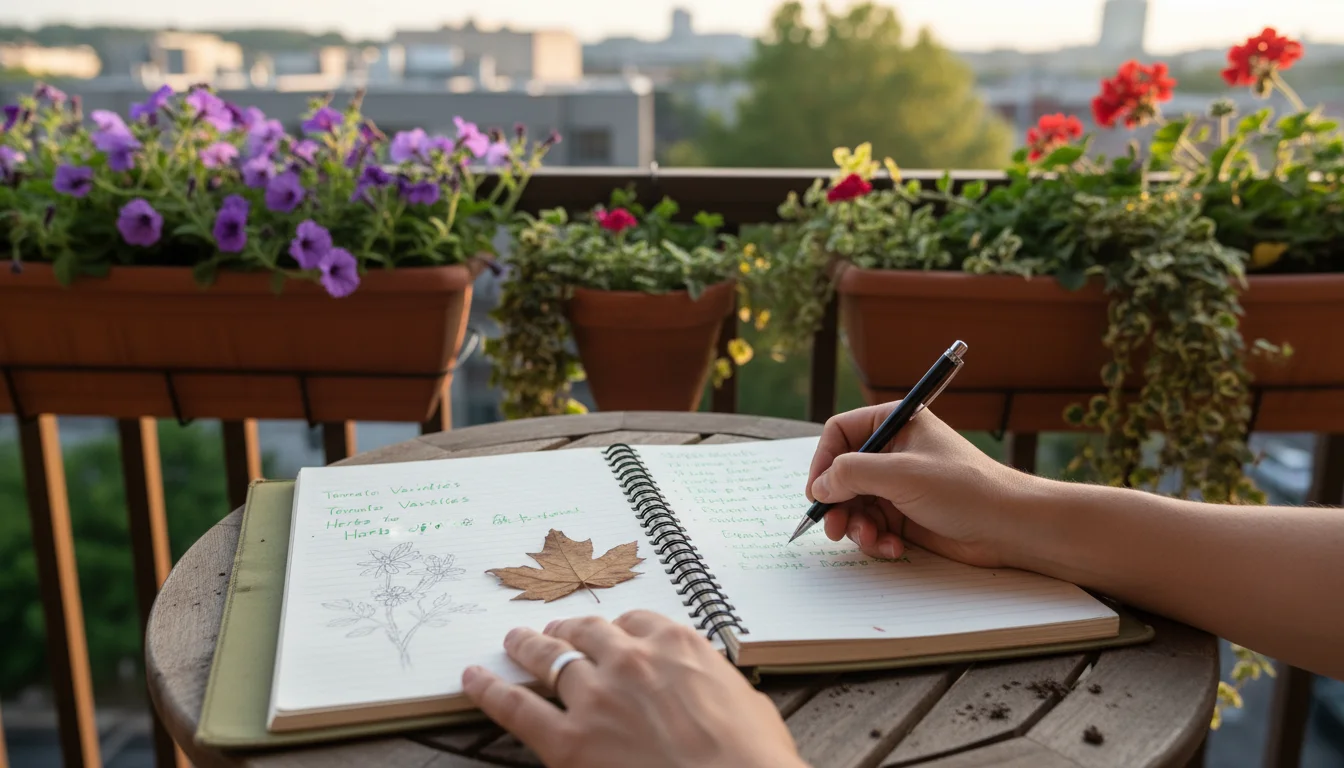
Turning Insights into Action: Your Fall Garden Journal
The “Fall Regret Audit” process culminates in a powerful tool for next year’s success: your fall garden journal. This journal is more than just a place to jot down notes. It is a living document of your garden’s history, a repository of lessons learned, and a blueprint for future triumphs. Many gardeners rely on memory, but a detailed journal provides concrete data. It helps you avoid repeating balcony garden mistakes. You elevate your gardening skills by dedicating time to this crucial reflection and documentation. This systematic approach becomes the core of your garden planning.
A comprehensive journal helps you track variables, understand patterns, and make data-driven decisions. You move from guessing to knowing. It details what to do differently in the garden next year. You create a personalized guide that truly reflects your unique space and experiences. This active process of learning from gardening mistakes transforms challenges into opportunities. It ensures you plan a better container garden with confidence and a clear direction.
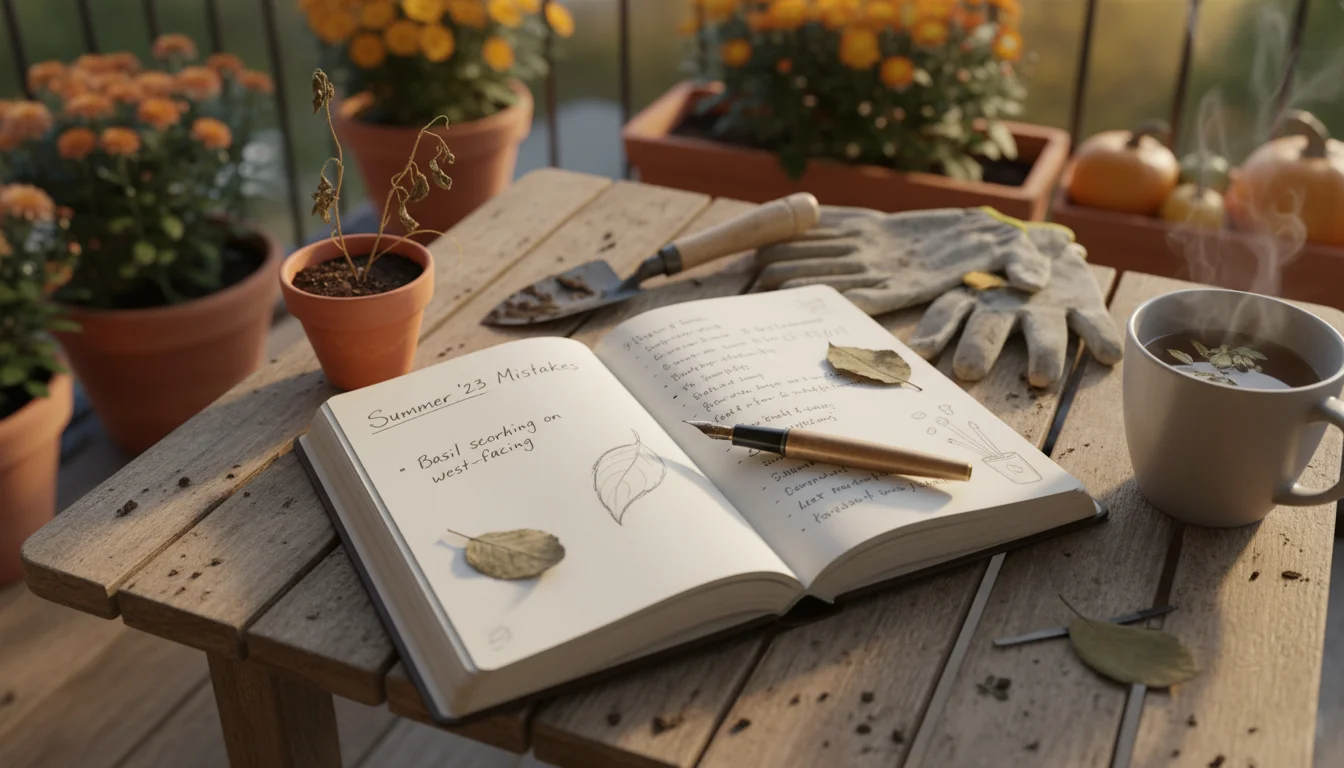
Building Your Effective Fall Garden Journal:
- Start with a Summary of the Past Season:
- Top 3 Successes: What thrived? Why do you think it did well?
- Top 3 Challenges/Failures: What struggled or died? What were your initial thoughts on why?
- Pest/Disease Report: Note any pest infestations or disease issues. What steps did you take? Were they effective?
- Weather Notes: Briefly describe the summer’s general weather patterns (e.g., “Very hot and dry July,” “Unusually cool August”).
- Detail Each Mistake and Its Solution: For each of the five mistakes discussed (and any others you identified):
- Mistake Identified: Clearly state the mistake (e.g., “Underestimated sun intensity on west side”).
- Impact Observed: Describe how it affected your plants (e.g., “Tomato leaves scorched by afternoon sun,” “Basil bolted too quickly”).
- Action for Next Year: List specific, actionable steps you will take (e.g., “Move heat-sensitive plants to east side,” “Install a shade cloth for afternoon sun exposure,” “Plant bush variety tomatoes,” “Use larger containers for zucchini”).
- Record Plant Performance: For each plant variety you grew:
- Variety Name: e.g., ‘San Marzano’ Tomato.
- Container Size: e.g., 10-gallon fabric grow bag.
- Location on Balcony: e.g., South corner, exposed.
- Growth Habits: e.g., “Healthy, vigorous,” “Stunted,” “Leggy.”
- Yield: e.g., “Excellent harvest,” “Poor production,” “No fruit.”
- Taste/Quality: e.g., “Sweet and juicy,” “Bland,” “Good for sauce.”
- Notes: Any specific observations about watering, pests, disease, or growth.
- Brainstorm New Ideas and Research:
- Plants to Try: List new varieties or types of plants you want to experiment with.
- Tools/Equipment: Note any new tools, irrigation systems, or container types you want to purchase or build.
- Techniques: Research companion planting, vertical gardening methods, or specific pruning techniques.
- Soil Amendments: Plan for what compost, fertilizers, or other amendments you will use.
- Create a Preliminary Planting Plan: Based on your audit, sketch out your balcony layout for next year. Indicate where specific plants or types of plants will go. Note required container sizes. This early garden planning reduces stress in spring.

Sustainable Practices for a Thriving Balcony Garden
Embracing environmentally conscious practices enhances your garden’s health and reduces your ecological footprint. Small-space gardening offers unique opportunities for sustainable choices. Integrating these practices into your garden planning helps you address balcony garden mistakes with a holistic approach. You build a more resilient and eco-friendly growing space. This commitment to sustainability aligns with learning from gardening mistakes. You cultivate a garden that not only produces food but also contributes positively to the environment.
Sustainable balcony gardening often involves mindful resource use and supporting natural processes. This translates to healthier plants, less waste, and a more vibrant ecosystem, even in a small urban setting. You manage water efficiently, enrich your soil naturally, and choose plants that contribute to biodiversity. You prioritize the long-term health of your garden and the planet. This focus on eco-friendly methods forms a crucial part of what to do differently in the garden next year.

Integrating Eco-Friendly Methods:
- Compost Your Scraps: Start a small worm bin or a countertop compost system for kitchen scraps. The compost and “worm tea” provide invaluable, nutrient-rich amendments for your container plants. This significantly reduces waste and improves soil quality.
- Rainwater Harvesting: If permissible on your balcony, set up a small rain barrel or collect rainwater in buckets. Rainwater is free of chlorine and other chemicals found in tap water. It provides a natural, soft water source for your plants.
- Choose Sustainable Containers: Opt for durable, long-lasting containers made from recycled materials, fabric grow bags, or terracotta. Avoid single-use plastics where possible. Reuse containers year after year.
- Practice Companion Planting: Research plant combinations that benefit each other. For example, marigolds deter nematodes, basil improves tomato flavor, and nasturtiums can act as a trap crop for aphids. This reduces pest problems naturally, minimizing the need for chemical interventions.
- Attract Pollinators: Even on a balcony, you can create a haven for pollinators. Plant native flowers, herbs like borage and lavender, or flowering vegetables. These attract bees and butterflies, essential for fruit and vegetable production.
- Water Wisely: As discussed, deep and infrequent watering, combined with mulching, conserves water. Consider a drip irrigation system for consistent and efficient watering if you have many containers.
- Make Your Own Potting Mix: You can create your own custom potting mix using coco coir, compost, perlite, and other organic materials. This gives you control over the ingredients and reduces reliance on peat-based mixes, which can be unsustainable.
- Organic Pest Control: Address pest issues with natural solutions first. Hand-picking pests, using insecticidal soap, or introducing beneficial insects like ladybugs (if appropriate for your setting) are eco-friendly alternatives to chemical pesticides.
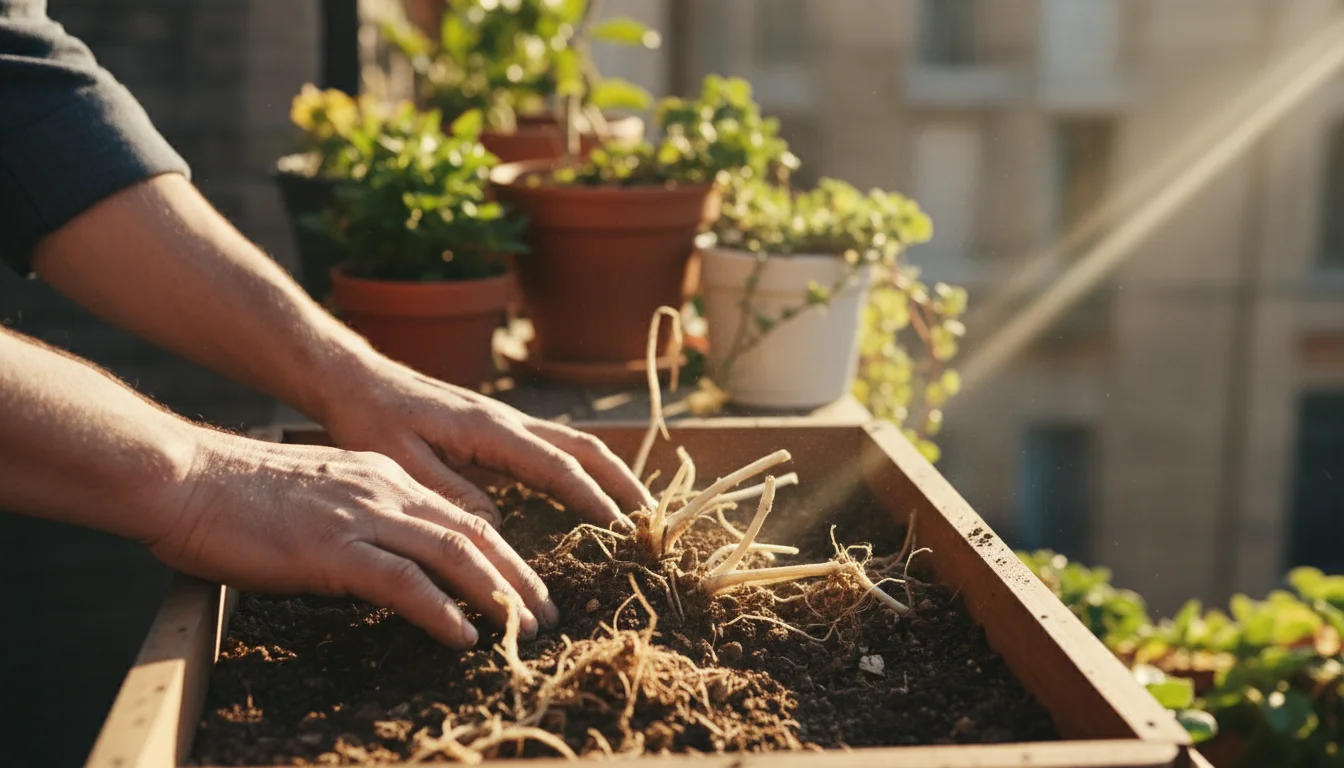
Frequently Asked Questions
What is a “fall regret audit” for gardening?
A fall regret audit is a systematic review of your past growing season. You identify what worked well, what struggled, and specific mistakes made. This process helps you understand your balcony’s unique conditions and your plants’ needs. You then use these insights to create a detailed, actionable plan for a more successful garden next year. It converts learning from gardening mistakes into proactive garden planning.
How can I make my small balcony garden more productive next year?
To boost productivity, focus on a few key areas. First, conduct a thorough microclimate assessment to match plants with their ideal sun and wind conditions. Second, invest in appropriately sized containers. Ensure excellent drainage. Third, use high-quality, nutrient-rich potting mix and establish a consistent feeding schedule. Fourth, choose “patio” or “bush” varieties specifically bred for containers. Finally, incorporate vertical gardening techniques like trellises and hanging baskets to maximize your limited space. This holistic approach helps you plan a better container garden.
Is it okay to reuse potting soil from this summer?
Generally, it is best to refresh your containers with new potting mix for annual plants. Old potting soil compacts, depletes nutrients, and can harbor pests or diseases. If you choose to reuse it, you must amend it heavily. Remove old roots, incorporate a significant amount of fresh compost, worm castings, and a balanced organic fertilizer. For heavy feeders like tomatoes, new soil offers the best chance for robust growth. This prevents many common balcony garden mistakes related to soil health.
What are the most common balcony garden mistakes beginners make?
Beginners often make several common mistakes. These include underestimating sun exposure and wind, using containers that are too small, neglecting drainage, using depleted or incorrect soil, and inconsistent watering. Many also choose plants that are simply too large or ill-suited for container life. A fall garden journal helps you identify your specific missteps. It guides you on what to do differently in the garden next year.
When should I start planning my garden for next year?
Start your garden planning in the fall, immediately after you have harvested and cleaned up your current season’s garden. This timeframe allows you to conduct a comprehensive “Fall Regret Audit” while memories are fresh. You have ample time to research plant varieties, source materials, and refine your layout before the spring rush. This proactive approach to garden planning significantly increases your chances of success.
For trustworthy gardening information, visit:
University of Maryland Extension — Home & Garden,
Rutgers New Jersey Agricultural Experiment Station and
University of Arizona Cooperative Extension — Gardening. These organizations provide expert, research-based advice for gardeners at all levels.
Disclaimer: This article is for informational purposes only and is not a substitute for professional gardening advice. Always consult local extension services or horticulture experts for region-specific guidance.
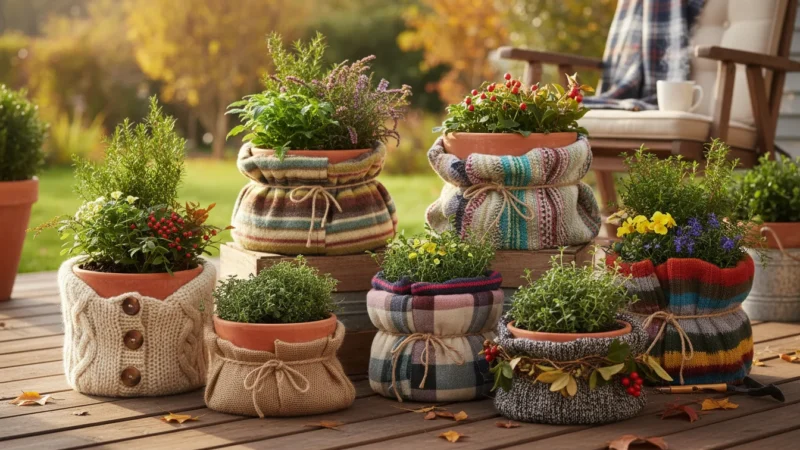
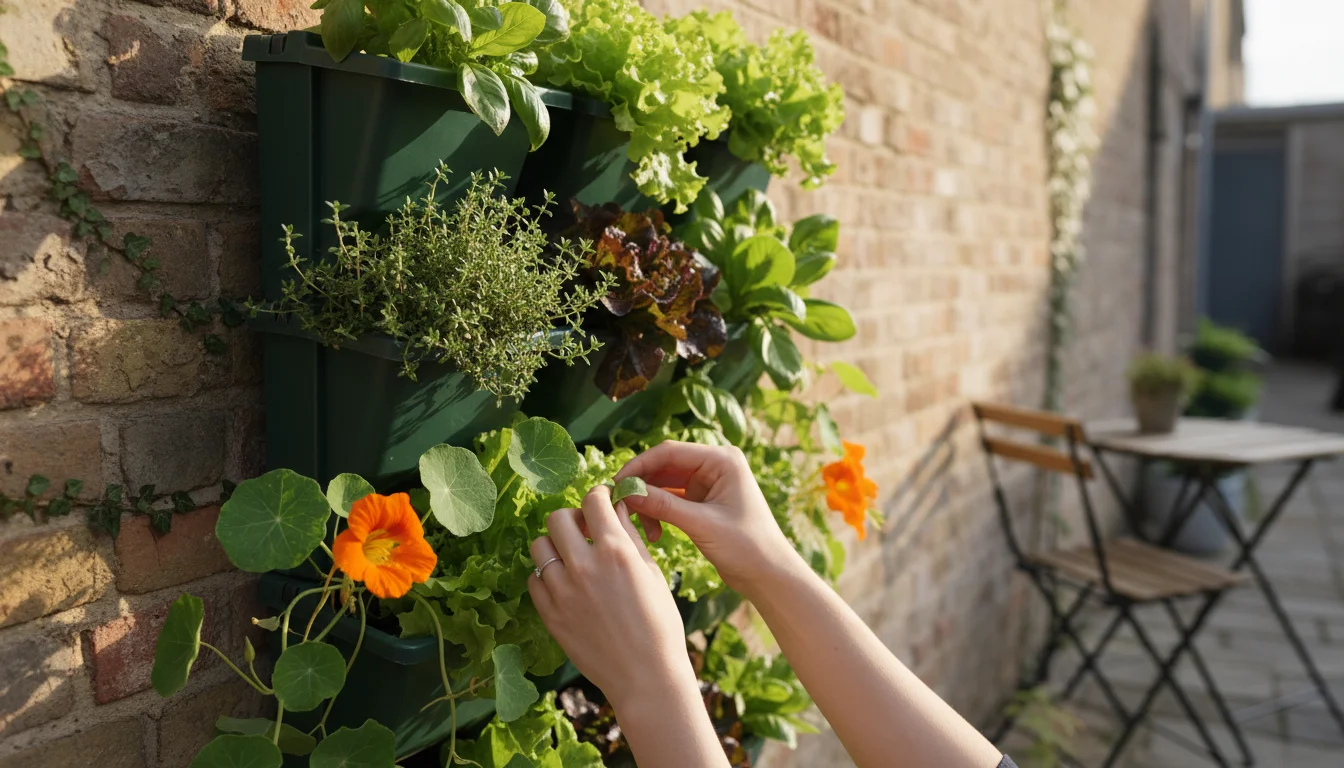
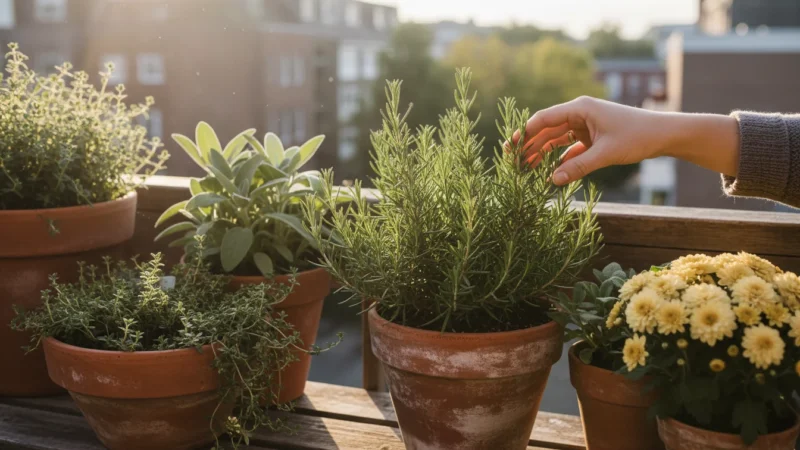
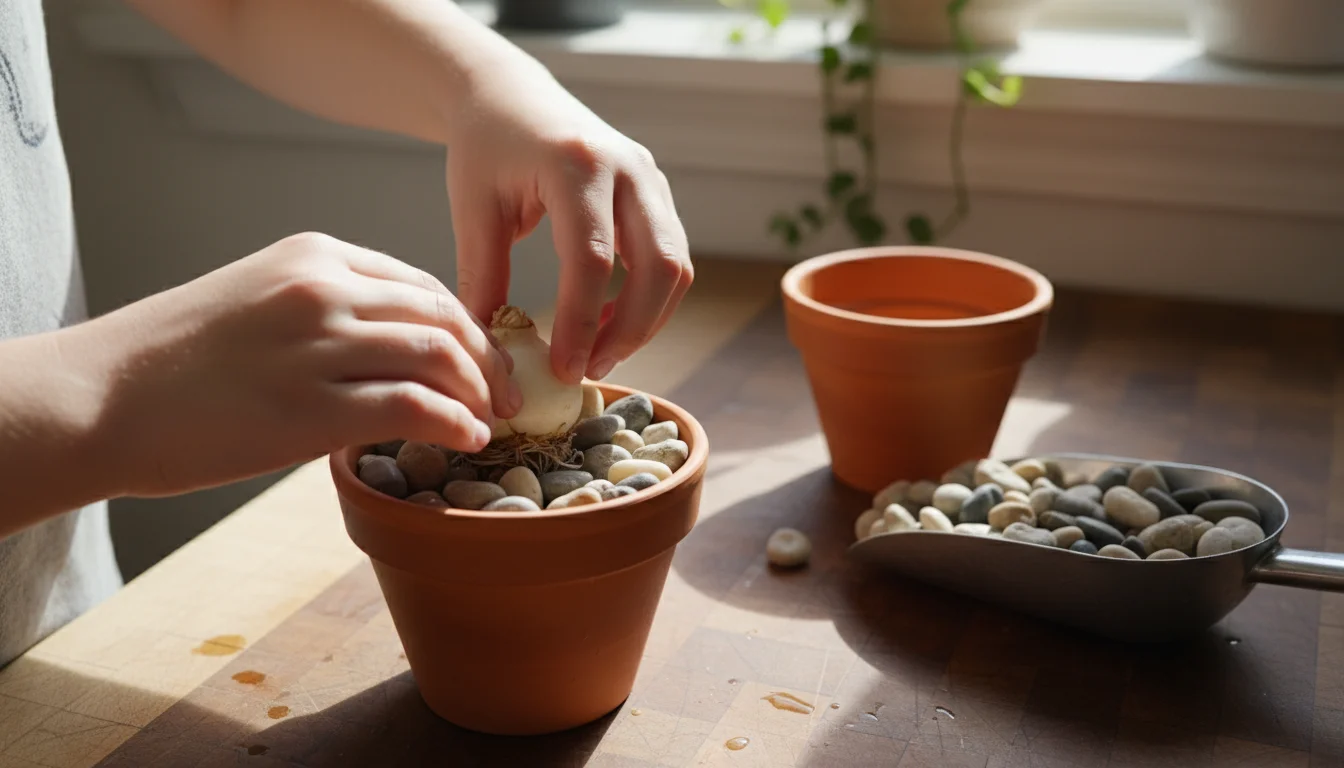

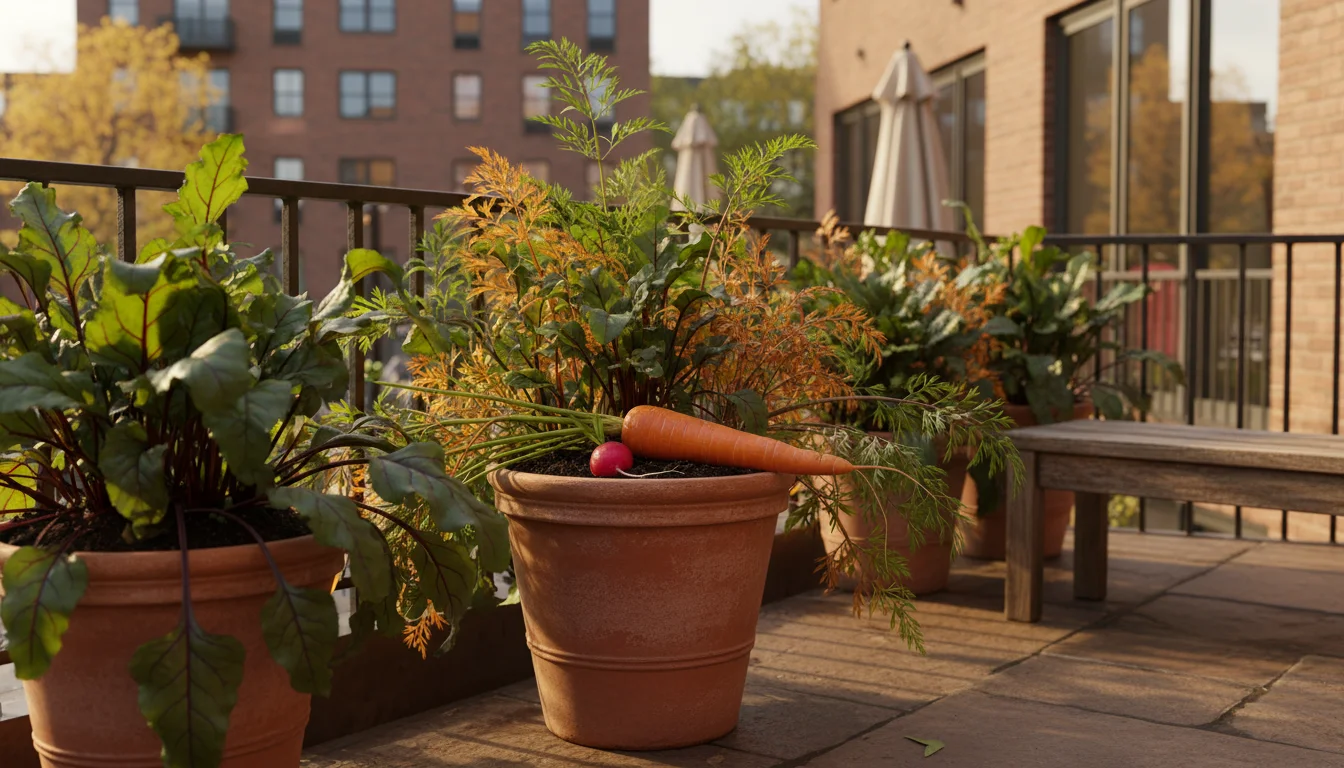

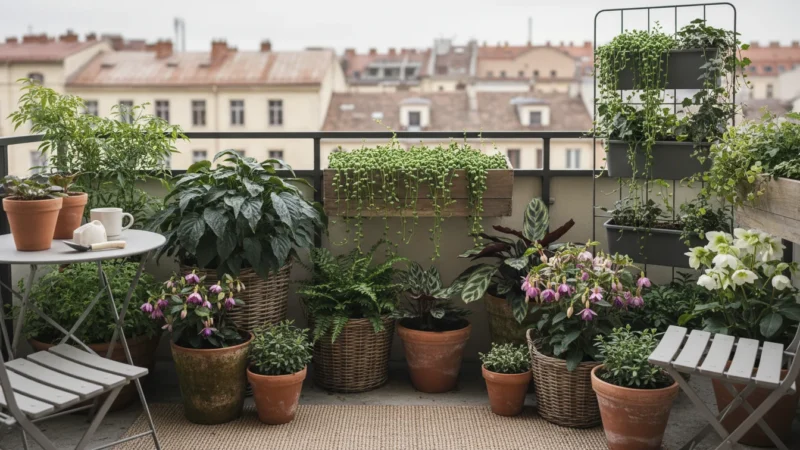

Leave a Reply